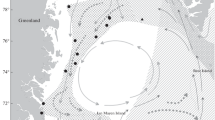Abstract
The occurrence of the fish Cephalopholis taeniops (Serranidae: Epinephelinae) has been recorded for the first time in the Canary Islands (eastern subtropical Atlantic). Repeated observations of adult stages of the species (≈30 cm total length) inside oil platforms coming from the Gulf of Guinea greatly suggest an introduction related to the transport of ballast water in these structures, and show their importance in the dispersal of adult stages of large-sized species of littoral fish. Oil platforms constitute one special case in the introduction of marine species in the context of ballast water transport. This poorly known phenomenon may greatly favour marine species invasion, and might have significant repercussions in many regions -especially in the current climate change context- as well as explaining some surprising cases of occurrence of expatriated adult individuals of certain species.
Similar content being viewed by others
References
Ben Abdallah A, Ben Souissi J, Méjeri H, Capapé C, Golani D (2007) First record of Cephalopholis taeniops (Valenciennes) in the Mediterranean Sea. J Fish Biol 71:610–614
Ben Rais Lasram F, Mouillot D (2009) Increasing southern invasion enhances congruence between endemic and exotic Mediterranean fish fauna. Biol Invasions 11:697–711
Brito A (1991) Catálogo de los peces de las Islas Canarias. Francisco Lemus Editor, La Laguna
Brito A, Falcón JM, Herrera R (2005) Sobre la tropicalización reciente de la ictiofauna litoral de las islas Canarias y su relación con cambios ambientales y actividades antrópicas. Vieraea 33:515–525
Carlton JT (1989) Mans role in changing the face of the ocean—biological invasions and implications for conservation of near-shore environments. Conserv Biol 3:265–273
Collignon J, Aloncle H (1973) Catalogue raisonné des poissons des mers marocaines. Deuxieme partie. Bull Inst Pech Maroc 21:1–267
Fowler HW (1936) The marine fishes of West Africa. Based on the collection of American Museum Congo Expedition 1909–1915. Bull Am Mus Nat Hist 70, part 1:1–605; part 2:606–1493
Galil BS (2008) Alien species in the Mediterranean Sea—which, when, where, why? Hydrobiologia 606:105–116
Gascuel D, Laurans M, Sidibé A, Barry MD (2002) Diagnostic comparatif de l′état des stocks et évolutions d′abondance des ressources démersales dans les pays de la CSRP. Actes du Symposium international, Dakar (Sènègal), 24–28 juin 2002, pp 1–14
Goren M, Gayer K, Lazarus N (2009) First record of the Far East chamaleon goby Tridentiger trigonocephalus (Gill, 1859) in the Mediterranean. Aquat Invasions 4:413–415
Guidetti P, Giardina F, Azzurro E (2010) A new record of Cephalopholis taeniops in the Mediterranean, with considerations on the Sicily channel as a biogeographical crossroad of exotic fish. Mar Biodiv Rec 3:e13
Heemstra PC, Randall JE (1993) Groupers of the world. FAO Species Catalogue, no 16. Rome
Lozano F (1970) Carasteristiques zoogeographiques de la faune ichthyologique des cotes des Iles Canaries, du Maroc, du Sahara Espagnol et de la Mauritanie avec une etude speciale des poisons cotiers. Rapp p-v 159:152–164
Maigret J, Ly B (1986) Les poissons de mer de Mauritanie. Centre National de Recherches Océanographiques et des Pêches, Sciences Naturelles publications, Copiègne
Maurin C (1968) Ecologie ichthyologique des fonds chalutables atlantiques (de la baie ibéro-marocaine à la Mauritanie) et de la Méditerranée occidentale. Rev Trav Inst Pêches marit 32(1):1–145
Ramos AG, Martel A, Codd GA, Soler E, Coca J, Redondo A, Morrison LF, Metcalf JS, Ojeda A, Suárez S, Petit M (2005) Bloom of the marine diazotrophic cyanobacterium Trichodesmium erythraceum in the Northwest African upwelling. Mar Ecol Prog Ser 301:303–305
Ruiz GM, Carlton JT, Grosholz ED, Hines AH (1997) Global invasions of marine and estuarine habitats by non-indigenous species: mechanisms, extent, and consequences. Am Zool 37:621–632
Salameh P, Sonin O, Golani D (2009) First record of the African hind (Cephalopholis taeniops) (Pisces: Serranidae) in the Levant. Annales Ser Hist Nat 19(2):151–154
Séret B, Opic P (1990) Poissons de mer de l′Ouest africain tropical. ORSTOM, Paris
Smith CL (1981) Serranidae. In: Fischer W, Bianchi G, Scott WB (eds) FAO species identifications sheets for fishery purposes. Eastern Central Atlantic; Fishing area 34, 47 (in part), vol 7. Canada Funds in Trust and FAO, Ottawa and Rome, pp 695–706
Smith CL (1990) Serranidae. In: Quero JC, Hureau JC, Karrer C, Post A, Saldanha L (eds) Check-list of the fishes of the Eastern tropical Atlantic, vol 3. UNESCO, Lisboa, pp 695–706
Tariche O (2002) Life history and stock assessment of the African hind (Cephalopholis taeniops) (Valenciennes, 1828) in Sao Vicente-Sao Nicolau insular shelf of the Cape Verde archipelago. Final Proyect 2002. The United Nations University, Fisheries Training Programme, Reykjavik
Toledo K, Sánchez-Jerez P, González-Lorenzo G, Brito A (2009) Detecting the degree of establishment of a non-indigenous species in coastal ecosystems: sea bass Dicentrarchus labrax escapes from sea cages in Canary Islands (Northeastern Central Atlantic). Hydrobiologia 623:203–212
Tortonese E (1986) Serranidae. In: Whitehead PJP, Bauchot ML, Hureau JC, Nielsen J, Tortonese E (eds) Fishes of the North-eastern Atlantic and the Mediterranean (1984–86, vol 3). UNESCO, Paris, pp 780–792
Wonham MJ, Carlton JT, Ruiz GM, Smith LD (2000) Fish and ships: relating dispersal frequency to success in biological invasions. Mar Biol 136:1111–1121
Acknowledgements
We thank the divers undertaking maintenance work of vessels in the ports of Las Palmas and Santa Cruz, especially O. Domínguez. We are also grateful to the sub-aqua fisherman A. Quintana. Thanks to M. M. Brito Campos and G. Jones, who assisted with the translation into English. This study was conducted within the framework of the ‘Proyecto Estructurante en Ciencias Marinas’ funded by the ‘Agencia Canaria de Investigación, Innovación y Sociedad de la Información’.
Author information
Authors and Affiliations
Corresponding author
Rights and permissions
About this article
Cite this article
Brito, A., Clemente, S. & Herrera, R. On the occurrence of the African hind, Cephalopholis taeniops, in the Canary Islands (eastern subtropical Atlantic): introduction of large-sized demersal littoral fishes in ballast water of oil platforms?. Biol Invasions 13, 2185–2189 (2011). https://doi.org/10.1007/s10530-011-0049-0
Received:
Accepted:
Published:
Issue Date:
DOI: https://doi.org/10.1007/s10530-011-0049-0




